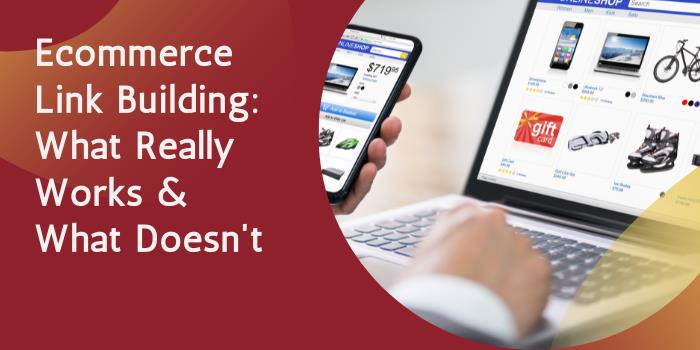Some of the most significant challenges every ecommerce client faces have revolved around developing a long-term and cohesive content/link-building strategy. They have practiced all the changes they could on the technical backend of the site, incorporated anchor texts, developed a crawlable internal linking system, submitted directory submissions, paid for PR releases, and written occasional blog posts. Now the question stands, what’s next?
One of the latest census surveys indicates that ecommerce retail revenues have risen quarter after quarter. This implies a limitless potential for the ecommerce sector’s future. Moreover, it is an enticing time to be involved in search engine optimization as most ecommerce businesses have realized that today is the day to emphasize content marketing. Not only does content marketing help distinguish your website, but it also offers a long-term solution.
Suppose your ideal destination (jokes apart) is page one; every road leads to ecommerce link building. However, out of three leading search SEO methods, comprising on-page, off-page, and technical SEO, ecommerce link-building approaches fall under off-page SEO. This is considered the least flamboyant way to hover on Google’s page one results. Even though they lack the pizazz of remarkable site speed or seamless designs, high-quality backlinks can build authority for ecommerce sites.
Image source: https://www.istockphoto.com/photo/social-connecting-in-smart-city-at-night-gm874849032-244260273
One can have a flawless crawlable site with ideal content and structure. However, you do not stand a chance to rank higher if Google does not trust it. Quality backlinks are a vote of trust and confidence for potential customers and Google to get your site listed on page one. In simple terms, when authoritative and reliable websites link back, the activity signals to customers and search engines that your ecommerce site deserves the traffic. On the other hand, to obtain that traffic, you need to earn relevant links suitably, implying you’ll need a practical and efficient ecommerce strategy to build links.
Do it Right or Don’t Do it at All.
There are no shortcuts to ecommerce search engine optimization for link-building purposes. Like every marketing strategy, you can discover straightforward methods to develop an excellent online backlink profile. But, such inferior approaches will only backfire and put your business at risk with a list of laundering penalties, such as delisting the whole ecommerce site from various search engines.
One of the golden rules for capturing inbound links is to stick to white hat link-building strategies and prevent the inclusion of any black hat ones. Here, a ‘white hat’ strategy means digital marketing techniques that abide by the webmaster regulations and enhance the entire user experience, such as designing unique and in-detail content. On the other hand, ‘black hat’ refers to jerry-built methods that can manipulate various search engines to rank higher and faster. This also comprises experimenting and playing with the PBNs, hidden links, and link farms.
Encompassing marketing values like honesty and integrity are vital to any strategy. While utilizing white-hat link-building techniques, you can achieve excellent results for your ecommerce site. Suppose you are building links. In that case, consider selecting top-ranking websites with extremely high domain authority. Like online viewers acknowledge a domain’s quality, Google can do the same. This is why the site’s quality linked to your content piece is relatively more integral than a specific number of backlinks.
Finding and integrating high-potential keywords is essential when it concerns a prominent platform’s architecture. The further-most pillar of search engine optimization that needs discussion is how to process link-building strategies for ecommerce sites. As already discussed, links play an integral role in the world of search engines. One of the traditional consequences is that they contribute more than 50% to your optimization success. Meanwhile, with regards to internal links, they are links found within websites. On the other hand, external links are linked to external websites.
Inside SEO, several ecommerce sites tend to struggle a lot with link-building. That is due to controllability. However, link building is an approach that does not involve many difficulties. Like every other facet of search engine optimization, it required determination and suitable approaches.
In short, know that Optimized Links = More Potential Revenue. It simply implies – do not leave money on your table.
How does the process work?
Link building is a method that invites various websites to link to your parent site. Since they provide you with external links, such links are votes of confidence and trust, allowing the website to pass on authority, trust, and relevancy.
Image source: https://www.istockphoto.com/vector/link-building-concept-vector-illustration-gm1188603816-336214717
Authority
Authority constitutes a considerable role. In addition, there are three kinds of authority a user must know:
- Page Authority: It only comprises page links in question.
- Domain Authority: The DA considers every link to the parent domain.
- Link Authority: It’s about the level of authority a link must pass on from page 1 to page 2.
The higher the figure of the website authority, the better. For example, every website’s dream is to acquire specific links from sites like nationalgeographic.com.
Relevancy
Speaking of relevancy, it is one of the links that link to a page from a topic-specific page. Suppose you are trading televisions. In that case, it would be ideal for your website to obtain a link from blog posts talking about the best televisions on the market to watch Premier League football on. Subsequently, link relevancy helps build your brand’s authority in the digital space.
Trust
Here, trust does not signify an emotion but online dependency. Trust is the extent to which Google and other engines trust your domain. Again, having higher trust between your domain and the search engines would be best. Furthermore, it is earned through duration, affixing to Google’s regulations, and obtaining links from reputable and reliable sites. If you’re unaware of an example, an ideal one would be a newspaper.
As a result, consider building reliable links ethically and aim to cater to your visitors well. Once you have done the basics right, trust will follow.
Building links to pack a punch.
While links pass on relevancy, authority, and trust, what else should you look for? Some of the other properties of links you should look out for are:
- Link target and origin
- Nofollow attribute
- Anchor text
The key to successful link-building is to develop the right content strategies and outreach techniques, enabling you to build quality links more efficiently and boost the visibility of your landing pages and site.
Before moving ahead, knowing what works while performing ecommerce link-building is essential. Here are some articulated yet beneficial tactics for your online business to succeed.
Embrace Video Marketing
Video content assists in bringing your products and their stories to life via narratives, walk-throughs, and in-depth instructional videos. The medium also allows a user to design various forms of content for a substantial audience, from institutional know-how and how-to to entertaining stories and slapstick humor.
Such an approach proves invaluable in your pursuit of building efficient links that can engage the potential audience and steer higher click-through rates. Video marketing ranks at the top on search engines with the potential for featured snippets. Let’s assume you operate an ecommerce business selling modern-day fashion. An ideal way to tempt links and clients would be to create fun and enticing videos on topics like eight incredible ways to lace your kicks or 20 modern ways to wear chinos. You’re not restricted to numbers while compiling a concept for the first video. Instead, focus on research and what would appeal to your target market.
You can also expand your audience reach by releasing video content on YouTube. Once you’ve gone that way, it’s best to administer the analytics now and then to see who embeds the video.
Extreme Products to Build Links
Yet another method to obtain links and build buzz around the brand is to promote and stock extreme products. This can either be a fragment of your seasonal collection or a new arrival. Such a technique has the potential and capacity to eschew traditional demographics and attract a mass audience.
By building links in this product type’s proximity, you are driving considerable traffic to the site while producing significant interaction through multiple social avenues.
Use Influencers for Content Assets
A piece of research recommends that ‘Generation Y,’ the dominant consumer demographic, is progressively cynical of huge names and sponsored texts, making the entire link-building process relatively challenging for ecommerce brands.
Moreover, it is one of the challenges neatly cornered by various online fashion retailers to build links and develop potent content assets. In simple terms, ASOS built funded accounts for specific influencers and known fashion bloggers who would publish pictures of themselves on social media channels like Instagram wearing branded clothing. In such posts, a viewer would be directed to targeted links like ‘buy the look,’ while also consisting of relevant lifestyle content and fashion tips.
Create Features That Make Products Shareable
The most practical link-building campaign of recent times included Getty Images Embed, which has approximately 50 million pictures from several users for free use on social media websites and blogs. The gravity of this engagement was such that it made the services shareable to the target audience and potential users, designing an actual path for expanding the concept and redirecting the traffic back to their site.
As a result, instead of attempting to develop organic links through remote posts or external content sections, a user can redirect traffic directly to a page housed at the brand’s heart, should they make striking images embeddable. Such a campaign makes the potential for every link to be distributed past your client network, producing more sales figures and traffic.
Offer Samples to Influential Bloggers
Image source: https://www.istockphoto.com/photo/helping-a-customer-gm1335198062-417030803
Offering product samples to influencers is an ideal way to secure coverage and direct engagement, traffic, and links to your site. Truth be told, collaborate with influential bloggers in your niche. In addition, perform thorough research on your industry competition to see which influencers they work with and study where their products are showcased and reviewed online. If you’re unaware of the software used for such an action, consider using Majestic or Ahrefs to identify the bloggers linking to them. Moreover, even a straightforward Google search can do the job, like ‘product + review.’
Since most bloggers might naturally review your samples without incurring any cost, others could propose a prepaid plan. It allows the content to go live as sponsored content, falling under the paid advertorial category. Unless the sample is of significant value, any influencer will request a specific monetary benefit in exchange for the review. Yet another practical tip is to utilize the numbers provided by the Mozbar extension. This checks the DA of the blogger’s blog. So, the higher their website’s domain authority, the better it is for your blog to secure inbound links.
Create Compelling Blogs & Utilize Integrated Content Marketing
As online algorithms are evolving continuously and prioritizing natural links, several brands have hopped onto the bandwagon to target specific content pieces as the primary part of their approach.
As already discussed, this doesn’t funnel users directly to integral product pages of a brand, which further creates the need to develop an internal linking paradigm that incorporates your content marketing methods. This can influence the user’s journey and the efficacy of your link-building methods. As a result, it’s worth investing in it. In addition to your approach, shape your blog to complement the strategy through hosting quality and relevant content that may deliver strong links. And at the same time, it provides you with natural conduct to particular product links.
Link building can sometimes discourage brands and websites that envisage SEO to enhance and push their site to the top spot on search results. And, if specific link-building methods are not working as you thought they would, there might be a few reasons contributing to the downfall. The rundown demonstrates particular ways that do not work in ecommerce link-building.
Possibility 1: Not enough time has elapsed
While your website is undergoing link-building activities, you might expect the links to impact rankings immediately and reach. However, that’s not the case. Considering how quickly Google crawls over the web, you may contemplate that new inbound links would directly affect your website. Based on the number of times Google reviews the site and the sites from which you obtained inbound links, it might take some weeks or a few months to check the results of such links. In the end, if you have indulged in link-building for only a few days or weeks, consider waiting for a month initially.
Possibility 2: There are not enough links
Yet another probability is that a user has not obtained sufficient links. Even though your website received some links from authoritative websites, would you call it a day or work hard towards sustaining the momentum? While you concentrate on relevant links, there’s a chance you might not have many quality links to enhance your rank. To know how to build valuable links and how many are sufficient, refer to tools like SEMrush and Ahrefs to operate a report on their platforms.
Possibility 3: The links are ineffective
If building links does not work for you, even though you’ve received several inbound links from various sites, the links might be ineffective, to begin with. This implies that the links redirecting to your website are not quality ones. Mentioned are some of the reasons why such links can be ineffective:
- Links from a new website.
- Not much content is present on the website.
- Links are not relevant to your website’s content.
For instance, links from a cafe review channel to a cafe website will weigh more than an ecommerce website that sells car equipment. When a link is effective, it all comes down to its effectiveness.
Possibility 4: Competitor websites building links
Image source: https://www.istockphoto.com/photo/mad-biracial-woman-frustrated-by-computer-operational-problems-gm1186588005-334842883
Let’s suppose you have begun your link-building campaign. Initially, everything might run smoothly, and you might gain a little ranking boost. However, when you come back a month later, your website might have fallen back. This is when you realize it’s not just your brand trying to build links in the same niche. As a result, you’re strategizing an approach and keeping an eye out for your competitors.
Possibility 5: Have you received a Google penalty?
If your link-building strategy isn’t working for quite some time, this might be because of a Google penalty that didn’t catch your eye. In Google’s terms, it could be an algorithmic penalty. Google continuously refreshes its automatic algorithm structure to enhance relevance and quality. When it occurs, websites found outside the quality guidelines might incur a penalty and push down the ranking structure.
The Bottom Line
Like all inspiring marketing efforts, ecommerce link-building is a journey, not a destination. Such a method relies on locating unlinked mentions, publishing linkable content, implementing an affiliate link program, and finding and rectifying broken links.
Besides, it is simply impossible to build a potent and trustworthy backlink profile overnight. What works for one might not work for you. And, those strategies and approaches that do not work for you should be administered more than what works in your website’s favor. Consequently, build a system that suits your site and is easily adaptable. Furthermore, do not overlook Google updates while putting a plan of action in order.







